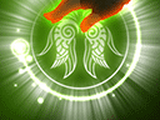Players can form groups to overcome game challenges. These are known as parties, a system that offer tools for cooperative play such as sharing EXP and loot, apply and receive buffs to other playable characters, gain access to the party chat channel and participate on instance type content. Parties are limited to a maximum of 5 teams.
Creating a Party[]
Any player can create a party through the Create Party button found at the bottom of the party window (F6). Clicking on it will instantly create a party with a default random name in the format Party#AAAAAA. The player that created the party will be the party leader, having a crown over its class icon, and is the only party member allowed to change the party settings.
It is possible to change the party name in the same tab. This feature is mostly used to identify the party goal when doing instance based content. There's also a description field below that was used on the public party system. However, this feature was discontinued and later removed. After changing those fields, the party leader has to click on the save button to confirm the alterations.
Recruitment, Joining and Leaving Party[]
To join a party you need to receive a party invitation or click on a party tag. Invitations are less commonly used but are more direct and personal. Any party member can send an invitation by right clicking the desired team character and select the invite to party option. The invited player will receive a prompt with basic information related to the party and buttons to accept or decline it. A new invitation has to be sent if the request is declined.
Party tag is the most commonly used method as it applies to all players, doesn't expire, and allow different players to use it. Any party member can use party tags. This feature is available through the Insert Party Invite Tag button found at the bottom of the party window (F6). It will generate the tag to the current chat channel. All players with access to that chat channel will be able to join the party until it has all slots filled. This can be done as long as the party has at least one player in it.
To leave a party you must open the party window (F6) and click the Leave Party button at the bottom of the window. The leadership status will be transferred if doing it as the party leader.
Party Management[]
When in a party, players will have access to EXP, loot and quest features that are applied as a group. These can be adjusted by the party leader based on preference. It is recommended to consult party members when changing the party settings to a non-default configuration. By default, parties will be set with Round Robin, Equal EXP and Quest Sharing Enabled configurations.
| Item Distribution | Individual | Each player collects its own items. |
|---|---|---|
| Round Robin | Distributes items collected them evenly, keeping track of how many units each player received. | |
| Random | Collected items are distributed at random. | |
| EXP Distribution | Individual EXP | Players receive EXP based on their damage contribution. |
| Equal EXP | EXP is distribute evenly among all party members. | |
| By Level | Distribute EXP proportional to the playable characters levels, prioritizing higher level characters. | |
| Quest Sharing | Disabled | Limits quest settings to individual use. |
| Enabled | Enables quest progression to be applied to all party members, including quest warps. |
The last two management options are leadership transference and expelling. Those two can be done at the party window (F6) by clicking on the desired party member.
Questing[]
When doing quests as a party, some special rules are applied. • Progress is shared only if the quest is activated. • Quests that require defeating a given number of enemies or obtaining special items from enemies will be applied even if another player defeats them. • All players that completed the quest or have the quest active will be teleported when a cutscene starts. • Each player can set one quest to have information shared. This will reveal its basic details, progress and enable quest warp if available.
Matchmaking System[]
For instance based content, a matchmaking system will be available. This feature allows players to form temporary parties tied to the game mode. The matchmaking system can be used while in a party, both for individual and group use, and is only applied within the instance. Once assembled, the player will be sent to the instance. All party related features will be directed to the instance party including the party chat channel. Once the player leaves, the instance it will regain access to the party features from the non-instance party.
| This page is currently at stage 2 and will contain some sort of element missing. We'll be working to advance it forward in the near future for more accurate information and better presentation.
|
All items (6)






